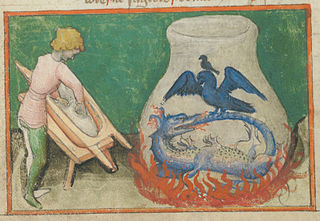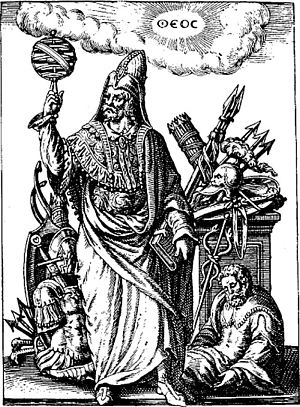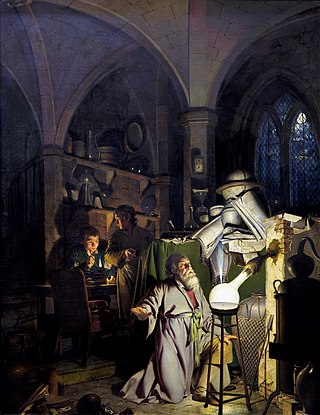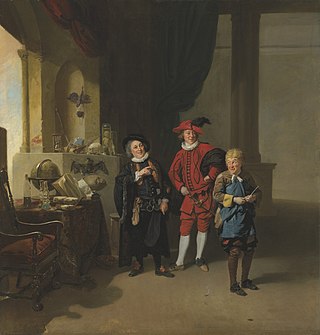Related Research Articles

Alchemy is an ancient branch of natural philosophy, a philosophical and protoscientific tradition that was historically practiced in China, India, the Muslim world, and Europe. In its Western form, alchemy is first attested in a number of pseudepigraphical texts written in Greco-Roman Egypt during the first few centuries AD.

Rosicrucianism is a spiritual and cultural movement that arose in Europe in the early 17th century after the publication of several texts announcing to the world a new esoteric order. Rosicrucianism is symbolized by the Rosy Cross or Rose Cross.

Hermes Trismegistus is a legendary Hellenistic period figure that originated as a syncretic combination of the Greek god Hermes and the Egyptian god Thoth. He is the purported author of the Hermetica, a widely diverse series of ancient and medieval pseudepigraphica that lay the basis of various philosophical systems known as Hermeticism.

The philosopher's stone is a mythic alchemical substance capable of turning base metals such as mercury into gold or silver. It is also called the elixir of life, useful for rejuvenation and for achieving immortality; for many centuries, it was the most sought-after goal in alchemy. The philosopher's stone was the central symbol of the mystical terminology of alchemy, symbolizing perfection at its finest, divine illumination, and heavenly bliss. Efforts to discover the philosopher's stone were known as the Magnum Opus.

Robert Fludd, also known as Robertus de Fluctibus, was a prominent English Paracelsian physician with both scientific and occult interests. He is remembered as an astrologer, mathematician, cosmologist, Qabalist and Rosicrucian.

Hermeticism or Hermetism is a philosophical and religious system based on the purported teachings of Hermes Trismegistus. These teachings are contained in the various writings attributed to Hermes, which were produced over a period spanning many centuries and may be very different in content and scope.

The Hermetica are texts attributed to the legendary Hellenistic figure Hermes Trismegistus, a syncretic combination of the Greek god Hermes and the Egyptian god Thoth. These texts may vary widely in content and purpose, but are usually subdivided into two main categories, the "technical" and "religio-philosophical" Hermetica.

The Corpus Hermeticum is a collection of 17 Greek writings whose authorship is traditionally attributed to the legendary Hellenistic figure Hermes Trismegistus, a syncretic combination of the Greek god Hermes and the Egyptian god Thoth. The treatises were originally written between c. 100 and c. 300 CE, but the collection as known today was first compiled by medieval Byzantine editors. It was translated into Latin in the 15th century by the Italian humanist scholars Marsilio Ficino (1433–1499) and Lodovico Lazzarelli (1447–1500).

Johannes Valentinus Andreae, a.k.a. Johannes Valentinus Andreä or Johann Valentin Andreae, was a German theologian, who claimed to be the author of an ancient text known as the Chymische Hochzeit Christiani Rosencreutz anno 1459. This became one of the three founding works of Rosicrucianism, which was both a legend and a fashionable cultural phenomenon across Europe in this period.

The Emerald Tablet, also known as the Smaragdine Tablet or the Tabula Smaragdina, is a compact and cryptic Hermetic text. It was highly regarded by Islamic and European alchemists as the foundation of their art. Though attributed to the legendary Hellenistic figure Hermes Trismegistus, the text of the Emerald Tablet first appears in a number of early medieval Arabic sources, the oldest of which dates to the late eighth or early ninth century. It was translated into Latin several times in the twelfth and thirteenth centuries. Numerous interpretations and commentaries followed.

Michael Maier was a German physician and counsellor to Rudolf II Habsburg. He was a learned alchemist, epigramist, and amateur composer.

Bibliotheca Philosophica Hermetica (BPH) or The Ritman Library is a Dutch library founded by Joost Ritman located in the Huis met de Hoofden at Keizersgracht 123, in the center of Amsterdam. The Bibliotheca Philosophica Hermetica brings together manuscripts and printed works in the field of Hermeticism, more specifically the 'Christian-Hermetic' tradition.

Ludovico Lazzarelli was an Italian poet, philosopher, courtier, hermeticist and (likely) magician and diviner of the early Renaissance.
Mary Anne Atwood was an English writer on hermeticism and spiritual alchemy.

Alchemy has had a long-standing relationship with art, seen both in alchemical texts and in mainstream entertainment. Literary alchemy appears throughout the history of English literature from Shakespeare to modern Fantasy authors. Here, characters or plot structure follow an alchemical magnum opus. In the fourteenth century, Chaucer began a trend of alchemical satire that can still be seen in recent fantasy works like those of Terry Pratchett.

The Rosary of the Philosophers is a 16th-century alchemical treatise. It was published in 1550 as part II of De Alchimia Opuscula complura veterum philosophorum (Frankfurt). The term rosary in the title is unrelated to the Catholic prayer beads; it refers to a "rose garden", metaphoric of an anthology or collection of wise sayings.
The following outline is provided as an overview of and topical guide to alchemy:
Hermeticism in poetry, or hermetic poetry, is a form of obscure and difficult poetry, as of the Symbolist school, wherein the language and imagery are subjective, and where the suggestive power of the sound of words is as important as their meaning. The name alludes to the mythical Hermes Trismegistus.

Cantilenae Intelectuales de Phoenice Redivivo or Intellectual Cantilenae is an alchemical book by Michael Maier, published in 1622. It was the final text of Maier's published during his lifetime. His dedication for the book, to Frederick, Prince of Norway is dated August 22, 1662, in Rostock.
Martin Stejskal is a Czech painter, graphic artist, translator, occasional poet, essayist, and author of texts and books dealing with different aspects of Hermeticism.
References
- ↑ "The Artwork of Modern Tarot - Database".
- ↑ "Home". surrealism.website.
- ↑ "Surrealism course - YouTube". YouTube .
- ↑ "Home". studioandgallery.co.uk.
- ↑ "The Studio and Gallery Kilbirnie". Herald Arts Magazine, Glasgow. 23 June 2018.
- ↑ ""Alchemical Translations"". www.amazon.com. Retrieved 27 January 2024.
- ↑ Adam McLean. “The Alchemy Website.” From interviews and autobiographical information. Retrieved 2011-12-30. http://www.alchemywebsite.com/adam.html
- ↑ Urszula Szulakowska. Alchemy in Contemporary Art. Surrey, 2011. p.5 ISBN 978-0-7546-6736-0
- ↑ Mike Dickman. Intellectual Cantilenae in Nine Triads upon the Resurrection of the Phoenix by Michael Maier. p. 1. Glasgow. 1992. ASIN: B001ACAK7U
- ↑ John Granger. "Alchemy: Jung, Burckhart, or McLean?" April, 2007. http://www.hogwartsprofessor.com/alchemy-jung-burckhart-or-mclean/